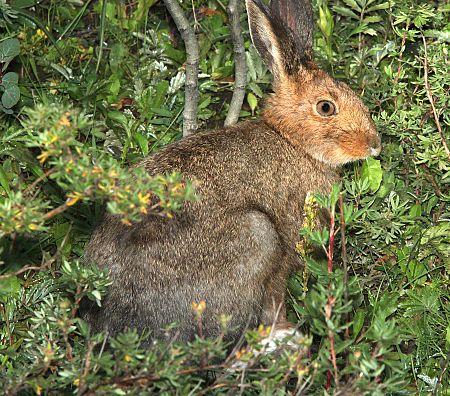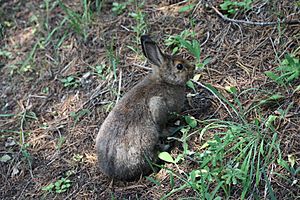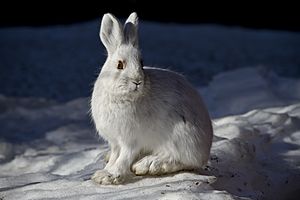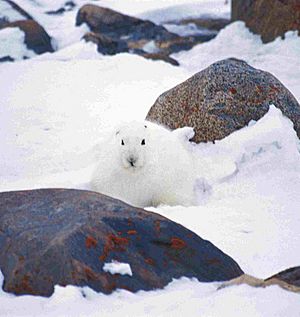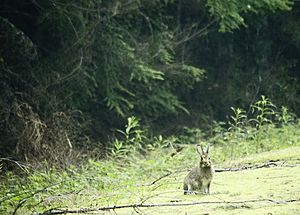Snowshoe hare facts for kids
Quick facts for kids Snowshoe hare |
|
|---|---|
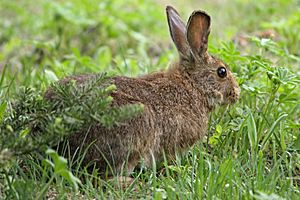 |
|
| Summer coat, photographed in Olympic National Park, Washington | |
 |
|
| Winter coat, photographed near Shirleys Bay, Ontario | |
| Conservation status | |
| Scientific classification | |
| Genus: |
Lepus
|
| Species: |
americanus
|
 |
|
| Snowshoe hare range | |
The snowshoe hare (Lepus americanus), also called the varying hare or snowshoe rabbit, is a species of hare found in North America. It has the name "snowshoe" because of the large size of its hind feet. The animal's feet prevent it from sinking into the snow when it hops and walks. Its feet also have fur on the soles to protect it from freezing temperatures.
For camouflage, its fur turns white during the winter and rusty brown during the summer. Its flanks are white year-round. The snowshoe hare is also distinguishable by the black tufts of fur on the edge of its ears. Its ears are shorter than those of most other hares.
In summer, it feeds on plants such as grass, ferns, and leaves; in winter, it eats twigs, the bark from trees, and plants and, similar to the Arctic hare, has been known to occasionally eat dead animals. It can sometimes be seen feeding in small groups. This animal is mainly active at night and does not hibernate. The snowshoe hare may have up to four litters in a year, which average three to eight young. Males compete for females, and females may breed with several males.
A major predator of the snowshoe hare is the Canada lynx. Historical records of animals caught by fur hunters over hundreds of years show the lynx and hare numbers rising and falling in a cycle, which has made the hare known to biology students worldwide as a case study of the relationship between numbers of predators and their prey.
Contents
Taxonomy and distribution
Snowshoe hares occur from Newfoundland to Alaska; south in the Sierra Nevada to central California; in the Rocky Mountains to southern Utah and northern New Mexico; and in the Appalachian Mountains to West Virginia. Populations in its southern range, such as in Ohio, Maryland, North Carolina, New Jersey, Tennessee, and Virginia have been extirpated.
Description
The snowshoe hare's fur is rusty brown in the spring and summer, and white in the winter. It also always has a gray underbelly, and black on the tips and edges of its ears and tail. It has very large hind feet, and dense fur on their soles. The snowshoe hare's ears are not as long as some other species of hares' ears. In the winter, it turns a bright white to blend in with the snow.
Snowshoe hares range in length from 413 to 518 mm (16.3 to 20.4 in), of which 39 to 52 mm (1.5 to 2.0 in) are tail. The hind foot, long and broad, measures 117 to 147 mm (4.6 to 5.8 in) in length. The ears are 62 to 70 mm (2.4 to 2.8 in) from notch to tip. Snowshoe hares usually weigh between 1.43 and 1.55 kg (3.15 to 3.42 lb). Males are slightly smaller than females, as is typical for leporids. In the summer, the coat is a grizzled rusty or grayish brown, with a blackish middorsal line, buffy flanks and a white belly. The face and legs are cinnamon brown. The ears are brownish with black tips and white or creamy borders. During the winter, the fur is almost entirely white, except for black eyelids and the blackened tips on the ears. The soles of the feet are densely furred, with stiff hairs (forming the snowshoe) on the hind feet.
Habitat
Snowshoe hares are primarily found in areas with dense plant coverage such as boreal forests, upper montane forests and wetlands, though are occasionally seen in more open areas like agricultural land.
In Utah, snowshoe hares used Gambel oak (Quercus gambelli) in the northern portion of the Gambel oak range. In the Southwest, the southernmost populations of snowshoe hares occur in the Sangre de Cristo Mountains, New Mexico, in subalpine scrub: narrow bands of shrubby and prostrate conifers at and just below timberline that are usually composed of Engelmann spruce, bristlecone pine, limber pine, and juniper.
In Minnesota, snowshoe hares are found in uplands and wetlands. In New England, snowshoe hares favor second-growth forests.
Reproduction
Snowshoe hares are nocturnal animals. They are shy and secretive and spend most of the day in shallow depressions, called forms, scraped out under clumps of ferns, brush thickets, and downed piles of timber. They occasionally use the large burrows of mountain beavers (Aplodontia rufa) as forms.
Snowshoe hares are active year-round. The breeding season for hares is stimulated by new vegetation. Breeding generally begins in late December to January and lasts until July or August. In northwestern Oregon, male peak breeding activity occurs in May and is at the minimum in November. In Ontario, the peak is in May and in Newfoundland, the peak is in June. First litters of the year are born from mid-April to May.
Litters average three to five leverets. Newborns are fully furred, open-eyed, and mobile. After leaving the birthplace, siblings stay near each other during the day, gathering once each evening to nurse.
The number of litters per year varies. In Alberta the average number of litters per year was almost 3 just after a population peak and 4 just after the population low. Females normally first breed as 1-year-olds.
Preferred habitat
Snowshoe hares prefer young forests with abundant understories. The presence of cover is the primary determinant of habitat quality, and is more significant than food availability.
Snowshoe hares wander up to 5 miles (8 km) when food is scarce.
Food habits
Snowshoe hares eat a variety of plant materials. Forage type varies with season. Succulent green vegetation is consumed when available from spring to fall; after the first frost, buds, twigs, evergreen needles, and bark form the bulk of snowshoe hare diets until spring greenup. Snowshoe hares typically feed at night and follow well-worn forest paths to feed on various plants and trees.
Predators
The snowshoe hare is a major prey item for a number of predators. Its foremost predator is the Canada lynx (Lynx canadensis), but other predators include bobcats (L. rufus), fishers (Pekania pennanti), American martens (Martes americana), Pacific martens, (M. caurina), long-tailed weasels (Neogale frenata), minks (N. vison), foxes (Vulpes and Urocyon spp.), coyote (Canis latrans), domestic dogs (C. familiaris), domestic cats (Felis catus), wolves (Canis lupus), cougars (Puma concolor), great horned owls (Bubo virginianus), barred owls (Strix varia), spotted owls (S. occidentalis), other owls, red-tailed hawks (Buteo jamaicensis), northern goshawks (Accipiter gentilis), other hawks (Buteonidae), golden eagles (Aquila chryseatos), as well as corvids. Other predators include black bears (Ursus americanus). In Glacier National Park snowshoe hares are a prey item of Rocky Mountain wolves (Canis lupus irremotus).
Vulnerability to climate change
The habitat for some snowshoe hares has changed dramatically, leaving some habitats without snow for longer periods than previously. Some hares have adapted and stay brown all winter. Others, however, continue to turn white in winter. These hares are at an increased risk of being hunted and killed because they are no longer camouflaged. Many people in the scientific community believe that snowshoe hare populations are at risk of crashing. Other species who rely on the hare as part of their diet are also at risk.



